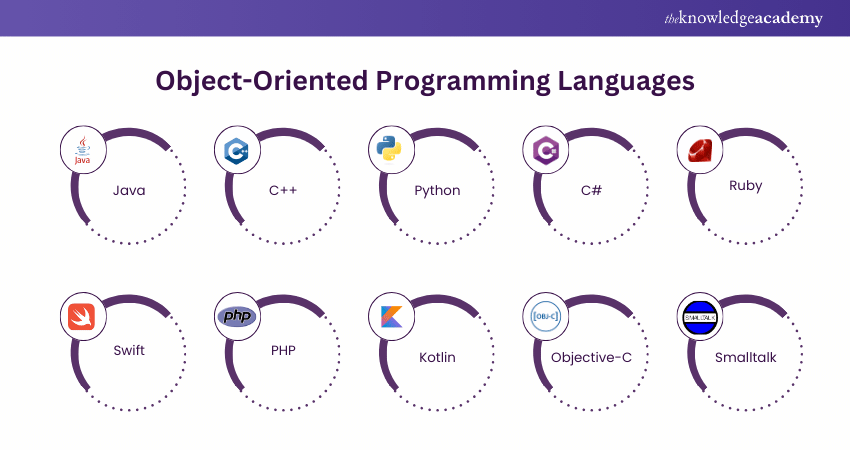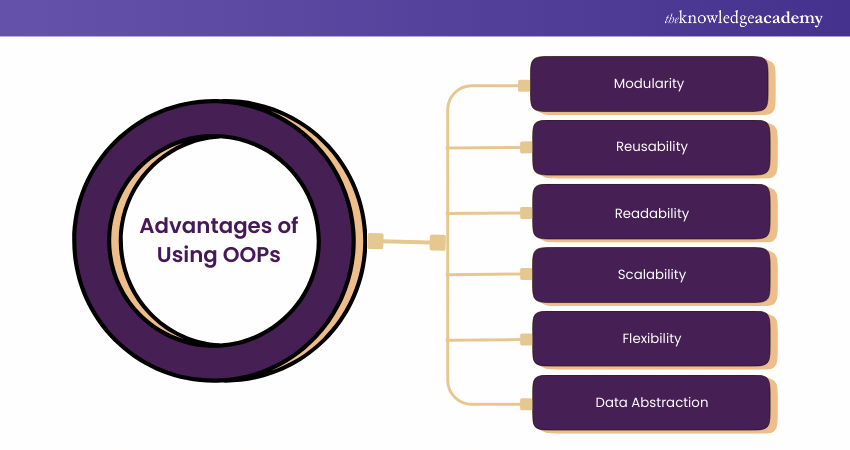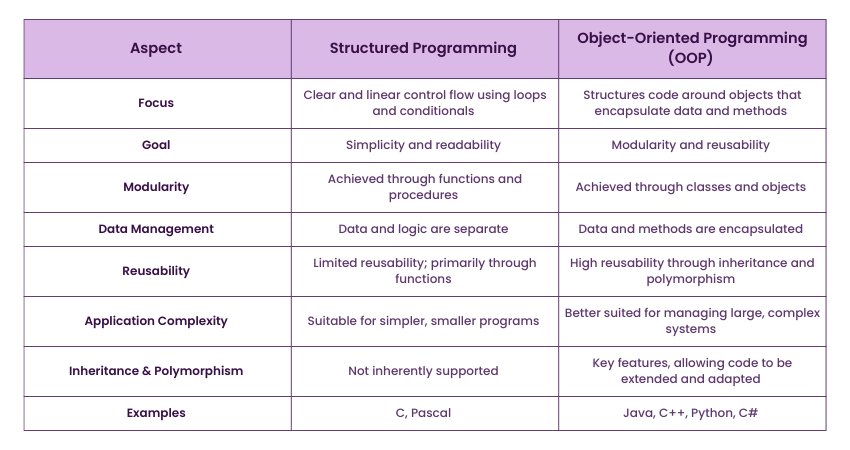We may not have the course you’re looking for. If you enquire or give us a call on +31 208081674 and speak to our training experts, we may still be able to help with your training requirements.
Training Outcomes Within Your Budget!
We ensure quality, budget-alignment, and timely delivery by our expert instructors.

Are you preparing for an interview and worried about those challenging OOP Interview Questions? Imagine walking into your interview with confidence, fully ready to tackle every question on Object-Oriented Programming. This blog is here to help you, featuring over 30 key OOPs questions that cover everything from the basics to advanced concepts.
Get ready to boost your knowledge and impress your interviewers with a solid understanding of Object-Oriented Programming. Whether you’re new to OOPs or looking to brush up on your skills, this blog will prepare you to handle any question with ease. Let's get started!
Table of Contents
1) Basic Level OOPS Interview Questions and Answers
2) Intermediate Level OOPS Interview Questions and Answers
3) Advanced Level OOPS Interview Questions and Answers
4) Conclusion
Basic Level OOPS Interview Questions and Answers
Embark on your journey into Object-Oriented Programming (OOPs) with these basic-level interview questions and answers, designed to test your foundational understanding of OOPS concepts.
1) What is meant by the term OOPs?
Object-Oriented Programming is a coding paradigm that structures software design around "objects," which combine data and methods. Key principles include encapsulation (bundling data and methods within objects), inheritance (creating new classes from existing ones), and polymorphism (treating objects as instances of their parent class).
OOPs promote modularity, making code more manageable and reusable, enhancing clarity and maintenance by mimicking real-world interactions. This approach not only simplifies complex systems but also facilitates easier updates and scalability as requirements evolve.
2) What is the need for OOPs?
OOPs addresses the complexity of Software Development by breaking down systems into manageable objects. It enhances code readability and maintainability, as objects encapsulate both data and behaviour.
This paradigm allows for better code organisation simplifies debugging, and fosters code reusability. By abstracting implementation details, OOPs make it easier for developers to understand and modify code without needing to grasp the entire system's intricacies.
3) What are some major Object-Oriented Programming languages?

Major Object-Oriented Programming languages include Java, which is widely used for enterprise applications; C++ for systems and application software; Python for its simplicity and versatility; C# for .NET applications; Ruby for web development; Swift for iOS apps; PHP for web scripting; Kotlin for Android development; Objective-C for legacy iOS apps; and Smalltalk, known for its influence on OOP concepts. These languages support OOP principles and are used in various domains.
4) What is meant by structured programming?
Structured Programming is a methodology that emphasises a clear, logical control flow using well-defined constructs such as loops (for, while), conditionals (if/else), and subroutines.
This approach aims to improve code readability and maintainability by organising program logic into manageable blocks, which simplifies debugging and development. It forms the foundation for various programming paradigms, including Object-Oriented Programming, which builds upon these principles to manage complexity.
5) What are the main features of OOPs?
The main features of Object-Oriented Programming are:
a) Inheritance: Allows a new class to inherit attributes and methods from an existing class.
b) Encapsulation: Bundles data and methods within a class, restricting direct access to some components.
c) Polymorphism: Enables objects to be treated as instances of their parent class, allowing methods to be overridden in derived classes.
d) Data Abstraction: Hides complex implementation details and exposes only essential features, making the interface simpler.
6) What are some advantages of using OOPs?
Object-Oriented Programming offers several advantages, including:

a) Modularity: Code is organised into objects, which enhances maintainability and scalability.
b) Reusability: Objects can be reused across different programs or projects, reducing redundancy.
c) Readability: Clear structure and organisation make code easier to understand and manage.
d) Scalability: Facilitates the development of complex systems by breaking them down into manageable components.
e) Flexibility: Polymorphism and inheritance enable versatile and adaptable code.
f) Data Abstraction: Simplifies interactions by hiding complex details.
7) Why are OOPs so popular?
Object-Oriented Programming is popular because it simplifies complex software design by structuring code into reusable and modular objects. This approach makes it easier to manage and maintain codebases, as objects encapsulate data and methods, enhancing clarity and reducing redundancy.
OOPs also supports scalability and flexibility, allowing developers to handle large projects efficiently. Its ability to model real-world entities and relationships makes it a preferred choice for modern Software Development.
8) What is an interface?
In programming, an interface defines a contract that specifies a set of methods that a class must implement. It outlines method signatures without providing their actual implementations. Any class that implements an interface agrees to provide its own specific implementation for these methods. This promotes consistency across different classes and allows for flexible, modular design by ensuring that classes adhere to a common protocol.
9) Can you call the base class method without creating an instance?
No, you cannot call a base class method without creating an instance of the class. Methods typically operate on the instance's attributes and require an object context to execute properly. The instance provides the necessary state and context for the method to interact with the object's data. Therefore, creating an instance of the class is essential for invoking its methods, including those defined in the base class.
10) What are the disadvantages of OOPs?
Object-Oriented Programming has some disadvantages, including:
a) Complexity: It can introduce complexity due to multiple classes and intricate relationships.
b) Performance Overhead: The abstraction layers in OOP may impact performance.
c) Learning Curve: Concepts like inheritance and polymorphism can be challenging for beginners.
d) Memory Overhead: Storing object-related data can increase memory usage.
e) Not Always Suitable: OOP may overcomplicate simpler projects and may not fit all scenarios.
f) Rigidity: The structure of OOP can sometimes be inflexible, making adaptations challenging.
11) What are virtual functions?
Virtual functions are methods declared in a base class that can be overridden by derived classes. The `virtual` keyword indicates that the method is intended to be overridden and enables dynamic binding.
When a virtual function is called on a base class pointer or reference, the actual implementation executed is determined by the type of object that the pointer or reference points to, allowing for flexible and dynamic method resolution.
12) What is the difference between Structured Programming and Object-Oriented Programming?

Structured Programming focuses on a clear and linear control flow using constructs like loops and conditionals to manage program logic, aiming for simplicity and readability.
Object-Oriented Programming, on the other hand, structures code around objects that encapsulate data and methods, promoting modularity and reusability. OOP builds on structured programming principles but adds features like inheritance and polymorphism to manage complexity in large systems.
13) What is hierarchical inheritance?
Hierarchical inheritance is a type of inheritance where multiple derived classes inherit from a single base class. This allows the derived classes to reuse and extend the functionality defined in the base class. It promotes code reusability and maintains a clear hierarchy, making it easier to manage and organise related classes. Each derived class can build upon or override the base class’s attributes and methods, facilitating structured and scalable design.
Enhance your programming skills with our comprehensive Programming Training designed to equip you with industry-ready expertise!
Intermediate Level OOPS Interview Questions and Answers
Step up your game with these intermediate-level OOPS Interview Questions and answers, perfect for those with a solid grasp of the basics and looking to deepen their knowledge.
14) What is encapsulation in OOPs?
Encapsulation is a fundamental OOP principle where an object’s data and methods are bundled together, restricting direct access to some components. This means that the internal state of an object is hidden from the outside world and can only be accessed or modified through public methods (getters and setters). Encapsulation enhances security, reduces complexity, and provides a clear interface for interacting with the object’s data and behaviour.
15) What is inheritance in OOPs?
Inheritance allows a new class to inherit attributes and methods from an existing class. The existing class is known as the base or parent class, while the new class is the derived or child class.
This mechanism promotes code reusability and establishes a hierarchical relationship between classes. Derived classes can extend or modify the functionality of base classes, facilitating the creation of more specialised and complex classes while avoiding code duplication.
16) What is polymorphism in OOPs?
Polymorphism in OOPs allows objects to be treated as instances of their parent class, enabling a single interface to represent different underlying forms (data types). It facilitates method overriding, where a derived class provides a specific implementation of a method defined in the base class.
Polymorphism supports dynamic method binding, allowing the appropriate method to be called based on the object's actual type at runtime. This enhances flexibility and scalability in programming.
17) What is the purpose of constructors in OOPs?
Constructors are special methods in a class used to initialise new objects. They are called automatically when an instance of the class is created and the object’s initial state is set up by assigning values to its attributes.
Constructors can be overloaded to provide different ways of initialising objects with various sets of parameters. They ensure that objects start their life in a consistent and valid state, ready for use in the program.
18) What are destructors in OOPs?
Destructors are methods that are invoked automatically when an object is destroyed or goes out of scope. They perform cleanup operations, such as releasing resources and memory allocated for the object.
Destructors help prevent memory leaks and ensure that resources are properly freed. They are crucial for managing dynamic memory and other resources that need explicit deallocation, maintaining efficient resource management and system stability.
19) What is the difference between method overloading and method overriding?
Method overloading allows multiple methods in the same class to have the same name but different parameters (types, numbers, or orders). It enables different functionalities to be implemented under a common method name, improving readability.
Method overriding, however, involves redefining a method in a derived class that already exists in the base class with the same name and parameters. It allows derived classes to provide specific implementations of inherited methods.
20) How do OOPs improve code reusability?
OOPs enhance code reusability by promoting the use of objects and classes, which can be reused across different parts of a program or in multiple projects. By encapsulating data and methods within classes, developers can create modular components that can be easily shared and extended.
Inheritance allows new classes to reuse and build upon existing code, reducing duplication and enabling efficient development practices through reusable code structures.
21) What is the role of access specifiers in OOPs
Access specifiers (private, protected, public) play a crucial role in Object-Oriented Programming by controlling the visibility and accessibility of class members (attributes and methods). Private members are accessible only within the class itself, which protects sensitive data and ensures that it is not modified unintentionally from outside the class.
Protected members can be accessed by the class itself and its subclasses, allowing for controlled extension while maintaining some level of encapsulation. Public members are accessible from any part of the program, providing an interface through which other classes or code can interact with the class. These specifiers help in enforcing encapsulation and protecting the integrity of data.
22) What is the significance of this pointer in OOP?
This pointer is a special pointer in Object-Oriented Programming that refers to the current instance of a class. It is used within instance methods to access or modify the instance's attributes and methods. This pointer helps differentiate between instance variables and local variables or parameters when they have the same name.
By using this, you can ensure that you are referencing the correct instance attributes, which is essential for accurate data manipulation. Additionally, this pointer allows the chaining of method calls, enabling more fluent and readable code by returning the current object from a method.
23) What is the difference between a static method and an instance method?
Static methods belong to the class itself rather than any specific instance. They can be called without creating an object of the class and do not have access to instance-specific data or methods. Static methods are useful for operations that are related to the class but not dependent on individual object state.
Instance methods, on the other hand, are associated with a particular object and can access and modify the instance's attributes and other instance methods. They require an object to be called and operate on the object's state, making them suitable for tasks that depend on individual object data.
Build a strong Python foundation with our expert-led Python Course which is ideal for aspiring developers and tech professionals!
Advanced Level OOPS Interview Questions and Answers
Challenge your expertise with advanced-level OOPS Interview Questions and answers, aimed at experienced candidates ready to tackle complex scenarios and demonstrate their mastery.
24) How do access modifiers affect inheritance in OOP?
Access modifiers dictate how class members are inherited by subclasses in Object-Oriented Programming. Public members of a base class are accessible to any class, including derived classes, allowing them to use and extend these members freely. Protected members are accessible within the base class and its derived classes but not from outside these classes, providing a balance between encapsulation and reusability.
Private members are not accessible to derived classes or outside the base class, ensuring that they remain hidden and can only be modified through methods defined within the base class. This structure helps in maintaining data integrity and controlling how the class's internal details are exposed.
25) What is an abstract class?
An abstract class in Object-Oriented Programming serves as a blueprint for other classes and cannot be instantiated on its own. It can contain abstract methods—methods that are declared but not implemented within the abstract class. These abstract methods must be implemented by any derived class, enforcing a contract for the derived classes to follow.
Abstract classes can also include concrete methods with implementations, which can be shared among derived classes. This allows abstract classes to define common attributes and behaviors while ensuring that specific details are provided by subclasses, promoting a structured and extensible class hierarchy.
26) What is a concrete class?
A concrete class is a class that is fully implemented and can be instantiated. Unlike abstract classes, concrete classes provide complete implementations for all their methods, meaning they are ready to be used to create objects. Concrete classes do not contain any abstract methods and can be instantiated directly to create objects.
They offer a concrete implementation of the behaviours defined in the class and can be used to build functional applications. Concrete classes can also be inherited from abstract classes or other concrete classes, gaining and extending their functionality.
27) What are some other programming paradigms other than OOP?
Besides Object-Oriented Programming (OOP), several other programming paradigms exist. Procedural programming focuses on procedures or routines and emphasises the sequential execution of tasks and functions. Functional programming revolves around the use of functions, immutability, and avoids changing state, promoting a declarative approach.
Database programming involves writing code to interact with and manage database systems, often using SQL and specialised languages for data manipulation and querying. Each paradigm offers distinct approaches to problem-solving and code organisation.
28) What is hierarchical inheritance?
Hierarchical inheritance is a type of inheritance in Object-Oriented Programming where a single base class is inherited by multiple derived classes. This structure allows all the derived classes to share common attributes and methods defined in the base class while each derived class can add or modify functionalities specific to its needs.
It promotes code reuse by enabling common functionality to be defined once in the base class and utilised across various subclasses. Hierarchical inheritance also helps in organising and structuring code more effectively, as it mirrors real-world hierarchies and relationships.
29) What is multiple inheritance?
Multiple inheritance is a feature in Object-Oriented Programming that allows a class to inherit from more than one base class. This allows a derived class to combine and utilise the attributes and methods of multiple parent classes, providing a way to aggregate functionality from various sources.
While it offers powerful flexibility and reuse of code, it can also introduce complexity and ambiguity, particularly with method resolution and conflicting member names. Many programming languages handle multiple inheritance through mechanisms like interfaces or mixins to manage these complexities and ensure a clear inheritance structure.
30) What is dynamic binding in OOP?
Dynamic binding, also known as late binding, is a mechanism in Object-Oriented Programming where method calls are resolved at runtime based on the actual type of the object rather than the type of the reference variable. This allows for more flexible and adaptable code, as objects of different classes can respond to the same method calls in different ways depending on their actual types.
Dynamic binding supports polymorphism, which means a method can perform different actions based on the object it is acting upon. This capability enhances code flexibility and enables more generic and reusable code structures.
31) What is the difference between Structured Programming and Object-Oriented Programming?
Structured Programming focuses on dividing a program into a set of procedures or functions that operate on data. It emphasises a top-down approach with a clear sequence of control structures like loops and conditionals. This paradigm aims to improve code clarity and reduce complexity through modular design.
Object-Oriented Programming (OOP), on the other hand, organises code around objects and classes, encapsulating data and behaviour together. It emphasises principles such as encapsulation, inheritance, and polymorphism, which help manage complexity by creating reusable, flexible, and maintainable code structures. OOP tends to model real-world entities more naturally and supports more robust software design.
32) What is the difference between a static method and an instance method?
Static methods are associated with the class itself rather than individual instances. They can be invoked without creating an object of the class and do not have access to instance-specific data or methods. Static methods are ideal for utility functions that do not require an object state.
Instance methods, in contrast, are tied to a specific object and operate on the data contained within that object. They require an instance of the class to be invoked and can access and modify the object's attributes and other instance methods. Instance methods are used for operations that depend on the particular state of an object.
33) What is the difference between method overloading and method overriding?
Method overloading occurs when multiple methods in the same class have the same name but different parameters (number, type, or both). It allows for different implementations based on the method signature and enhances code readability.
Method overriding happens when a subclass provides a specific implementation for a method that is already defined in its superclass. It allows the subclass to modify or extend the behaviour of inherited methods and is crucial for achieving runtime polymorphism in OOP.
34) What is encapsulation, and how does it contribute to Software Development?
Encapsulation is the principle of bundling data and methods that operate on that data into a single unit, typically a class. It hides the internal state of the object from the outside world and only exposes a controlled interface through public methods.
This contributes to Software Development by promoting modularity, reducing complexity, and protecting data integrity. Encapsulation helps in managing changes to the internal implementation without affecting external code, leading to more maintainable and robust software systems.
Unlock the potential of Object-Oriented Programming by registering in our Object Oriented Programming (OOPs) Course today!
Conclusion
Mastering OOPs Interview Questions is crucial for showcasing your programming skills. Understanding concepts like encapsulation and polymorphism will set you apart in your interviews. Use this blog to prepare thoroughly and confidently tackle any OOPs interview. With the right preparation, you’ll be well on your way to success.
Transform your PHP skills into advanced web solutions by registering for our expert-led PHP Course today!
Frequently Asked Questions

Encapsulation in OOP ensures data security by bundling data and methods into a single unit. It restricts access to internal details, promoting a more robust and secure code structure.

Polymorphism allows objects to be treated as instances of their parent class, promoting code flexibility by enabling the use of a common interface for various objects.

Inheritance fosters code reusability and extensibility by allowing a class to inherit attributes and behaviours from a parent class, facilitating the creation of a hierarchical structure in code.

The Knowledge Academy takes global learning to new heights, offering over 30,000 online courses across 490+ locations in 220 countries. This expansive reach ensures accessibility and convenience for learners worldwide.
Alongside our diverse Online Course Catalogue, encompassing 17 major categories, we go the extra mile by providing a plethora of free educational Online Resources like News updates, blogs, videos, webinars, and interview questions. Tailoring learning experiences further, professionals can maximise value with customisable Course Bundles of TKA.

The Knowledge Academy offers various Object Oriented Programming (OOPs) Course, including Python Course, PHP Course, Swift Training etc. These courses cater to different skill levels, providing comprehensive insights into Introduction to OOPs.
Our Programming & Devops blogs covers a range of topics related to Object Oriented Programming (OOPs), offering valuable resources, best practices, and industry insights. Whether you are a beginner or looking to advance your Project Management skills, The Knowledge Academy's diverse courses and informative blogs have you covered.

The Knowledge Academy’s FlexiPass is a pre-paid training voucher that is built specifically for clients and their dynamic needs. It provides access to a wide range of courses, at a pre-determined price, with robust safety measures. FlexiPass gives clients the added benefit of upskilling on a budget that best fits them.
Upcoming Programming & DevOps Resources Batches & Dates
Date
 Object Oriented Programming (OOPs) Course
Object Oriented Programming (OOPs) Course
Thu 1st Jan 1970







 Top Rated Course
Top Rated Course



 If you wish to make any changes to your course, please
If you wish to make any changes to your course, please


